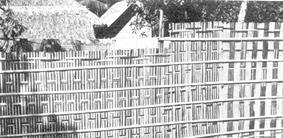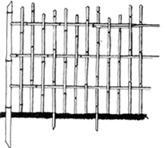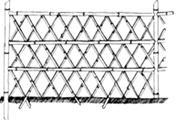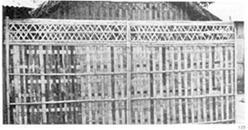
Several types of fence
constructions, using bamboo as a primary material, are in evidence. These vary form region
to region, reflecting the local understanding of the properties of the material, the state
or art in terms of technology available or techniques know, and the economy of
construction. The functional requirements are also deciphered from the variations of these
constructions. Fences used around fields have an open rigid structure, their height being
sufficient to prevent the entry of animals. In the plains, fences used around houses
indicate a need for privacy, as these are generally of a close weave and extend slightly
above human height to create the necessary visual barrier (fig.120). Some of these exhibit
an element of decoration.
Field
fences
 Simple open-type field fences seen in the plains, are made of
longitudinal splits of bamboo with interlacing horizontal and vertical members spaced well
apart (fig.121). In order to achieve a strong structure with an economical use of
materials, combinations of whole bamboo, longitudinal halves, quarters and splits of
smaller dimensions are used. Bamboo culms cut to suitable lengths are anchored in the
ground and used as posts. These are spaced apart, and horizontal members of longitudinal
halves are held between the posts. These may either be lashed on to the posts or attached
through a housed joint, where the horizontal member penetrates the post through a hole cut
in it. Simple open-type field fences seen in the plains, are made of
longitudinal splits of bamboo with interlacing horizontal and vertical members spaced well
apart (fig.121). In order to achieve a strong structure with an economical use of
materials, combinations of whole bamboo, longitudinal halves, quarters and splits of
smaller dimensions are used. Bamboo culms cut to suitable lengths are anchored in the
ground and used as posts. These are spaced apart, and horizontal members of longitudinal
halves are held between the posts. These may either be lashed on to the posts or attached
through a housed joint, where the horizontal member penetrates the post through a hole cut
in it.
 Another variation of the open-type field fence is made by
substituting all vertical members by ones placed diagonally in both directions (fig.122).
these diagonals interweave and have the horizontals woven through them. In some cases the
lower ends of these inclined members are sunk into the ground and the open ends at the top
are held sandwiched between two or more horizontal members lashed together to create a
strong upper edge. Another variation of the open-type field fence is made by
substituting all vertical members by ones placed diagonally in both directions (fig.122).
these diagonals interweave and have the horizontals woven through them. In some cases the
lower ends of these inclined members are sunk into the ground and the open ends at the top
are held sandwiched between two or more horizontal members lashed together to create a
strong upper edge.
 A third type of field fence, is made by flattening bamboo culms of
a small outer diameter and wall thickness, to form sheets which are about 35 to 45mm
wide-equal to the circumference of the bamboo. Here a desirable height of fence is
pre-determined by the width of the woven mats. Continuous diagonal sheets are interwoven
in one direction till these reach the edge of the fence structure. These diagonals twist
around the edge and return inclined in the opposite direction across the face of the
fence, weaving into the already existing diagonals. These fences are woven like a mat of
continuous running length, of fixed width, and are later propped up against
posts.(fig.123) A third type of field fence, is made by flattening bamboo culms of
a small outer diameter and wall thickness, to form sheets which are about 35 to 45mm
wide-equal to the circumference of the bamboo. Here a desirable height of fence is
pre-determined by the width of the woven mats. Continuous diagonal sheets are interwoven
in one direction till these reach the edge of the fence structure. These diagonals twist
around the edge and return inclined in the opposite direction across the face of the
fence, weaving into the already existing diagonals. These fences are woven like a mat of
continuous running length, of fixed width, and are later propped up against
posts.(fig.123)
House
Fences
 Fences around houses use bamboo boards made by flattening whole
culms, 50 to 70 mm in diameter. The fences are of the closed type, with the boards woven
closely packed together, without any gaps. The plain weave, the twill weave and
occasionally a decorative variation of the twill pattern are used (fig.125). the twill
weave structure with the elements taken diagonally as in braiding is predominantly used. Fences around houses use bamboo boards made by flattening whole
culms, 50 to 70 mm in diameter. The fences are of the closed type, with the boards woven
closely packed together, without any gaps. The plain weave, the twill weave and
occasionally a decorative variation of the twill pattern are used (fig.125). the twill
weave structure with the elements taken diagonally as in braiding is predominantly used.
|

 Simple open-type field fences seen in the plains, are made of
longitudinal splits of bamboo with interlacing horizontal and vertical members spaced well
apart (fig.121). In order to achieve a strong structure with an economical use of
materials, combinations of whole bamboo, longitudinal halves, quarters and splits of
smaller dimensions are used. Bamboo culms cut to suitable lengths are anchored in the
ground and used as posts. These are spaced apart, and horizontal members of longitudinal
halves are held between the posts. These may either be lashed on to the posts or attached
through a housed joint, where the horizontal member penetrates the post through a hole cut
in it.
Simple open-type field fences seen in the plains, are made of
longitudinal splits of bamboo with interlacing horizontal and vertical members spaced well
apart (fig.121). In order to achieve a strong structure with an economical use of
materials, combinations of whole bamboo, longitudinal halves, quarters and splits of
smaller dimensions are used. Bamboo culms cut to suitable lengths are anchored in the
ground and used as posts. These are spaced apart, and horizontal members of longitudinal
halves are held between the posts. These may either be lashed on to the posts or attached
through a housed joint, where the horizontal member penetrates the post through a hole cut
in it. Another variation of the open-type field fence is made by
substituting all vertical members by ones placed diagonally in both directions (fig.122).
these diagonals interweave and have the horizontals woven through them. In some cases the
lower ends of these inclined members are sunk into the ground and the open ends at the top
are held sandwiched between two or more horizontal members lashed together to create a
strong upper edge.
Another variation of the open-type field fence is made by
substituting all vertical members by ones placed diagonally in both directions (fig.122).
these diagonals interweave and have the horizontals woven through them. In some cases the
lower ends of these inclined members are sunk into the ground and the open ends at the top
are held sandwiched between two or more horizontal members lashed together to create a
strong upper edge. A third type of field fence, is made by flattening bamboo culms of
a small outer diameter and wall thickness, to form sheets which are about 35 to 45mm
wide-equal to the circumference of the bamboo. Here a desirable height of fence is
pre-determined by the width of the woven mats. Continuous diagonal sheets are interwoven
in one direction till these reach the edge of the fence structure. These diagonals twist
around the edge and return inclined in the opposite direction across the face of the
fence, weaving into the already existing diagonals. These fences are woven like a mat of
continuous running length, of fixed width, and are later propped up against
posts.(fig.123)
A third type of field fence, is made by flattening bamboo culms of
a small outer diameter and wall thickness, to form sheets which are about 35 to 45mm
wide-equal to the circumference of the bamboo. Here a desirable height of fence is
pre-determined by the width of the woven mats. Continuous diagonal sheets are interwoven
in one direction till these reach the edge of the fence structure. These diagonals twist
around the edge and return inclined in the opposite direction across the face of the
fence, weaving into the already existing diagonals. These fences are woven like a mat of
continuous running length, of fixed width, and are later propped up against
posts.(fig.123) Fences around houses use bamboo boards made by flattening whole
culms, 50 to 70 mm in diameter. The fences are of the closed type, with the boards woven
closely packed together, without any gaps. The plain weave, the twill weave and
occasionally a decorative variation of the twill pattern are used (fig.125). the twill
weave structure with the elements taken diagonally as in braiding is predominantly used.
Fences around houses use bamboo boards made by flattening whole
culms, 50 to 70 mm in diameter. The fences are of the closed type, with the boards woven
closely packed together, without any gaps. The plain weave, the twill weave and
occasionally a decorative variation of the twill pattern are used (fig.125). the twill
weave structure with the elements taken diagonally as in braiding is predominantly used.